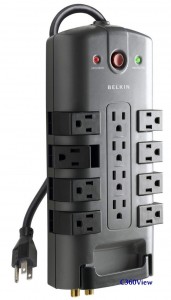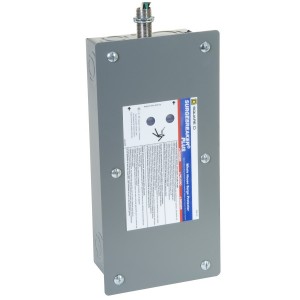INFORMATION ABOUT SURGE PROTECTORS
 Most modern businesses and homes are supplied with 120/240 volt power systems.
Most modern businesses and homes are supplied with 120/240 volt power systems.
The normal voltage flow for 120 voltage will often range from 110-117 volts. Computers, printer, stereo equipment and TV sets have internal circuits sensitive to voltage fluctuations and are often protected by surge protectors. Heavy draw appliances such as air conditioners, dryers, and electric stoves generally have no need to be protected by surge protectors.
Surge Protectors are designed to trap the voltage that exceeds those limits. Excessive voltage occurs due to power spikes. When these spikes occur for a sufficient duration, this activates the trapping device, a Metal Oxide Varistor (MOV), located in the surge protector.
The MOV is the heart of surge suppressors. The role of the MOV is to divert surge current. However, MOVs wear out with use. As more surges are diverted, the MOVs life span shortens, and failure becomes imminent.
There is no forewarning or visual indications given – just failure. And while failing, they can reach very high temperatures, and actually start fires.
 Most surge protectors will continue to function as a power strip, even though the surge trap mechanism may have been destroyed by the power spike. This presents two possible dangers:
Most surge protectors will continue to function as a power strip, even though the surge trap mechanism may have been destroyed by the power spike. This presents two possible dangers:
1) If another power surge should occur, it can damage the equipment or appliances that are plugged into this surge protector, and
2) If sufficient voltage passes through the surge protector due to a second power spike, a resistant short may have been formed, allowing heating to occur and a fire to ignite.
When buying this equipment, look for a surge protector with an indicator light that tells you if the protection components are functioning. All MOVs will burn out after repeated power surges. Without an indicator light, you have no way of knowing if your protector is still functioning properly. Unfortunately due to manufacturing differences, the light may be “on” or “off” during proper operation. It is important to review the operating instructions provided with the surge protector. Every year, thousands of fires result from surge protectors, power strips and electrical cords. Listed below are some suggestions to help prevent a possible fire from igniting.
USE ONLY SURGE PROTECTORS OR POWER STRIPS THAT HAVE AN INTERNAL CIRCUIT BREAKER.
These units will trip the breaker if the power strip is over loaded or shorted to prevent overheating and fire.
All surge protectors or power strips need to be UL approved. Be sure that the product is listed as a TRANSIENT VOLTAGE SURGE SUPPRESSOR. This means that it meets the criteria for UL 1449, UL’s minimum performance standard for surge suppressors. There are a lot of power strips listed by UL that have no surge protection components at all. They are listed only for their performance as extension cords. On a UL listed surge protectors, you will find a couple of ratings. Look for:
* Clamping voltage. This tells you what voltage will cause the MOVs to conduct electricity to the ground line. A lower clamping voltage indicates better protection. There are three levels of protection in the UL rating– 330 V, 400 V and 500 V. Generally, a clamping voltage more than 400 V is too high.
* Energy absorption/dissipation. This rating, given in joules, tells you how much energy the surge protector can absorb before it fails. A higher number indicates greater protection. Look for a protector that is at least rated at 200 to 400 joules. For better protection, look for a rating of 600 joules or more.
* Response time. Surge protectors don’t kick in immediately; there is a very slight delay as they respond to the power surge. A longer response time tells you that your computer (or other equipment) will be exposed to the surge for a greater amount of time. Look for a surge protector that responds in less than one nanosecond.
Visually inspect all surge protectors or power strips on a regular basis to ensure that they are not damaged or showing signs of wear or damage. During the visual inspection, ensure that the plug is fully engaged in their respective outlets. The surge protector or power strips should always have either a polarized plug with one of the blades being larger than the other one or a three-prong grounded plug. Never use a three to two prong adapter to power the unit. Surge protectors or power strips should have a cord of no more than 6 feet in length. When the surge protector or plug strip is not in use, unplug the cord from the power source.
Article retrieved from:
http://www.nmsu.edu/safety/programs/gen_saf/Surge_unit_info.htm
Image retrieved from:
http://i.ebayimg.com/00/s/MTM3MFg3ODU=/z/0fwAAOxyVaBSvfPr/$_57.JPG
http://images.lowes.com/product/converted/785901/785901307136.jpg
For more surge safety articles click here.
